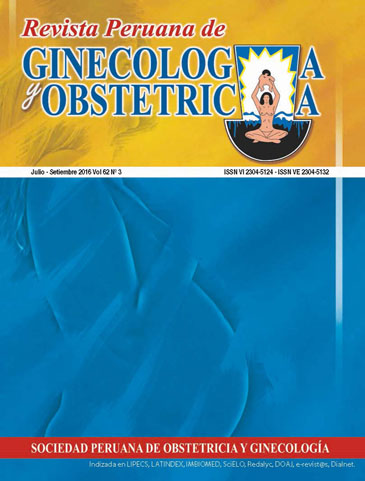Diagnóstico prenatal de anomalías cromosómicas Biopsia de vellosidades coriales y amniocentesis para cariotipo fetal
DOI:
https://doi.org/10.31403/rpgo.v62i1922Resumen
Introducción: El diagnóstico prenatal temprano de anomalías cromosómicas requiere de técnicas invasivas, como la biopsia de vellosidades coriales (BVC) y la amniocentesis (AMC), con el fin de obtener células fetales, cultivarlas y obtener el cariotipo en los fetos con riesgo alto para estas anomalías, identificadas mediante marcadores ecográficos y bioquímicos desde las 11 semanas. Reportamos nuestra experiencia hasta junio del año 2016. Diseño: Estudio descriptivo longitudinal. Institución: Instituto Latinoamericano de Salud Reproductiva (ILSAR), Lima, Perú. Participantes: Fetos de primer y segundo trimestres del embarazo. Intervenciones: Se analizó los resultados del estudio de 400 fetos que cursaban el primer y segundo trimestre y que tenían riesgo alto para anomalías cromosómicas (mayor de 1/270 inicialmente y 1/100 desde el año 2012), resultado cuantificado utilizando la base de datos del Fetal Test de España más el resultado de los marcadores bioquímicos (riesgo combinado). El análisis del cariotipo fetal se realizó en muestras obtenidas por medio de 338 amniocentesis genéticas y 62 biopsias de vellosidades coriales realizadas durante el período comprendido de enero 2003 a junio 2016 en nuestro centro ILSAR. Principales medidas de resultados: Presencia de arcadores ecográficos y normalidad de los cariotipos. Resultados: Los marcadores ecográficos encontrados con mayor frecuencia fueron: higroma quístico (35,8%), translucencia nucal aumentada (13%), ductus venoso con onda de velocidad de flujo anormal (8,5%), dos o más marcadores asociados a anomalías fetales (13,7%). De 400 muestras estudiadas, 141 (35%) fueron cariotipos anormales: 64 (45%) T21, 35 (25%) T18, 21 (15%) 45X, 7 (5%) T13, 14 (10%) otras anomalías. No hubo complicación importante alguna atribuida al procedimiento invasivo. Conclusiones: En los fetos con riesgo alto para anomalías cromosómicas estudiados, el 35% tuvo cariotipo anormal, siendo las más frecuentes las trisomías de los cromosomas 21 y 18, seguidas de la monosomía del cromosoma X. El higroma quístico, la translucencia nucal aumentada y la presencia de 2 o más marcadores asociados a anomalías fetales fueron los hallazgos más frecuentes en la determinación del riesgo ecográfico. El higroma quístico mostró el mayor valor predictivo para anomalías cromosómicas.Descargas
Los datos de descargas todavía no están disponibles.
Descargas
Publicado
2016-10-18
Cómo citar
Huamán G., M., Quiroga de Michelena, M. I., St. Martin, B., & Huamán J., M. (2016). Diagnóstico prenatal de anomalías cromosómicas Biopsia de vellosidades coriales y amniocentesis para cariotipo fetal. Revista Peruana De Ginecología Y Obstetricia, 62(3), 269–277. https://doi.org/10.31403/rpgo.v62i1922
Número
Sección
Controversias
















